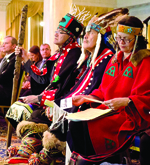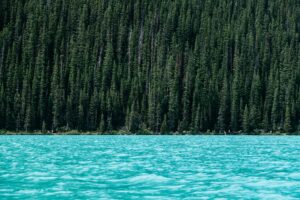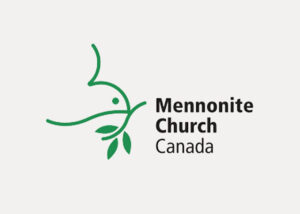As the battle over the proposed Northern Gateway Pipeline plays out, key questions about the moral make-up of Canada will be answered: questions about the balance between economic growth and environmental protection, and questions of whether large companies can bulldoze through unceded Aboriginal territory without local consent.
The answers to these questions—and it is not at all clear yet what those answers might be—will significantly shape the ethical course of our nation.
If built, the $5.6-billion Northern Gateway Pipeline would carry 525,000 barrels a day of bitumen from the Alberta oil sands through the territory of dozens of First Nations to the B.C. coast where it would be loaded onto supertankers headed mostly for Asia.
The 1,177-kilometre, 36-inch diameter pipeline would be accompanied by a second smaller line that would carry condensate—used to thin oil for transport—in the opposite direction. The lines would be buried a metre deep in a 25-metre wide right-of-way.
Calgary-based Enbridge, Canada’s largest transporter of crude oil, is the lead proponent on the project.
Churches are slowly and cautiously entering the Northern Gateway debate. Katy Quinn of Kairos—a social justice organization representing seven of Canada’s largest denominations—says the issue is a “game changer” in terms of its potentially profound implications for ecological sustainability and indigenous rights. She says the issue will be a “major focus” for Kairos, though it's not clear just what that involvement will look like.
As for other church involvement, Quinn says churches in general seem to be keeping a “fairly low profile” on the issue despite the high stakes.
Unwavering Resolve
The Harper government is fervently committed to the Northern Gateway project. Federal officials have famously branded opponents of the pipeline “radicals” and virtual enemies of the economy. They have threatened the charitable status of organizations that oppose the project. The government has also proposed changes to environmental laws will make large projects easier to build. Though it is not yet clear how much effect this will have on the Northern Gateway regulatory process, it sends a clear signal.
On the other side, Aboriginal opposition to the project has grown beyond anything seen in Canada for years.
“I’ll stand in front of a bulldozer if that’s what it takes,” says Chief Jackie Thomas of the Saik’uz First Nation. She’s not speaking metaphorically. And she’s not alone.
“Enbridge picked this battle and we’re going to win it,” Hereditary Chief Tsodih declared at a May 4 event in Winnipeg. He's from the Nak’azdli First Nation, just north of Saik’uz. The two First Nations, along with four others in the B.C. interior are part of the Yinka Dene Alliance which has come together to oppose the pipeline.
A delegation of 40 Yinka Dene representatives took the train to Toronto for the Enbridge AGM on May 9, making stops along the way to seek support from Canadians.
The Yinka Dene are joined by the Coastal First Nations, a coalition of 10 Aboriginal groups on the B.C. coast, in opposing the project. Dozens of other First Nations throughout B.C. have signed the Save the Fraser Declaration in opposition to the pipeline.
Other First Nations Buying In
Other First Nations have accepted Enbridge’s offer of construction contracts and a chance to purchase a combined 10 percent share in the project, something that could net them up to $300 million over 30 years. According to Todd Nogier, a senior communications strategist with Enbridge, “around 50 percent” of the 40 to 50 First Nations and Aboriginal communities within 80 kilometres of the pipeline route are now in favour of the project.
But despite the equity offering and nearly a decade of consultations with Aboriginal groups, Enbridge still faces seemingly unwavering opposition from a sizeable segment of the Aboriginal population in the pipeline corridor.
Risks
The primary concerns of opponents are that oil spills could ruin some of the roughly 1,000 rivers and streams the pipeline would cross and that a shipping accident in the narrow channels that lead from the terminus of the pipeline in Kitimat out to the open seas could destroy marine habitat over a huge area, as happened with the Exxon Valdez spill further north in 1989. About 220 ships per year—as large as 350 by 65 metres—would need to find their way through the waterways of the spectacularly beautiful Great Bear Rainforest area.
“Knowing the risks that it involves, we have to say no,” said Gerald Amos during a February presentation at Canadian Mennonite University. Amos is an elder who speaks for the Coastal First Nations. He lives down the road from where the supertankers would dock.
Nogier, speaking by phone from Calgary, says Enbridge has “complete confidence” that both the pipeline and the marine component of the project can be built and operated “very safely and sustainably.” But for people along the proposed corridor, those assurances are weighed against the record of the company and the broader pipeline industry.
In July 2010, an Enbridge pipeline leaked an estimated 19,000 barrels of oil into waterways in Michigan. Later that year, 6,100 barrels of oil spilled from an Enbridge line near Romeoville, Illinois.
Last week, another company, Plains Midstream Canada, reported a spill of up to 3,000 barrels into an Alberta river, in addition to 28,000 barrels that spilled from one of its northern Alberta pipelines last year.
Yinka Dene leaders point out that no one will guarantee them that there will be no spills on their land.
Economic Growth
Nogier emphasizes the economic benefits of the project, including an estimated $270-billion boost to Canadian GDP and $2.6 billion in tax revenues over 30 years. The company's website says that construction will bring “$400 million in employment and contracts to Aboriginal communities and businesses.” Nogier says Enbridge’s target is to have 15 percent of construction jobs go to Aboriginal and Metis people.
He says the project will result in 1,100 to 1,200 long term jobs, though the Enbridge website says only 217 of these would be directly related to the pipeline and the marine terminal, with the rest being spin-off jobs “throughout Canada.” Nogier says Enbridge does not have Aboriginal employment targets for the long term jobs.
Pending regulatory and cabinet approval Enbridge hopes to begin construction in 2014, with the first bitumen flowing by late 2017.
Unresolved Issues Loom
But many issues must be addressed first, not the least of those being Aboriginal rights. Many of the First Nations along the B.C. portion of the corridor have never signed treaties or otherwise ceded rights to their lands. These rights are recognized in the Constitution and in international law. Enbridge and the federal government cannot simply forge ahead without regard for these rights.
“It will end up in the Supreme Court,” Chief Thomas says by phone from northern B.C. That would take years.
Sue Eagle, Co-coordinator of Indigenous Work for Mennonite Central Committee Canada, says an essential principle in cases like this is Aboriginal consent, a principle MCC has worked to promote at the U.N. level. She says consultation has been “used and abused” in various situations across Canada, but consent— something emphasized in the U.N. Declaration on the Rights of Indigenous People, to which Canada is a signatory—should be the operative principle.
But with First Nations on different sides of the pipeline issue, “there are no easy answers,” she says.
Nogier says Enbridge is committed to seeking the consent of all Aboriginal groups along the corridor, but he acknowledges that unanimous approval is unlikely.
The stated policy of Enbridge is to “recognize the legal and constitutional rights possessed by Aboriginal and Native American Peoples,” but does that mean Aboriginal people have veto power?
“I don't think any one entity has a veto,” Nogier says. But he adds that it is the federal government, not Enbridge, that will ultimately decide whether or not to grant approval for the project. He says federal leaders will need to decide “what level of First Nations’ support they would like to see.”
If cabinet approves the pipeline despite a lack of Aboriginal consent, Nogier says it would be up to the board of Enbridge to decide whether to go ahead.
Rift
The distance between the sides remains considerable. A year ago, around the time of the 2011 Enbridge AGM—which Yinka Dene representatives also attended—Nogier says the company “opened the door wide” to ongoing consultations to work through differences and discuss benefits. But no ongoing dialogue resulted. The company “put out the plea” for dialogue again just prior to this year’s AGM.
Chief Thomas has a different version. She says the Yinka Dene invited Enbridge CEO Pat Daniel to their territory at last year’s AGM, but didn’t hear back until they were riding the train to this year’s meeting. The chiefs re-issued the invitation this year and Nogier says Daniel “indicated that he was very much in favour of doing that.”
But the varying versions of the Enbridge-Yinka Dene exchange are largely beside the point. When asked if there is anything Enbridge could to do make the Northern Gateway Pipeline acceptable to her, Chief Thomas doesn’t hesitate.
“No.”
She continues: “We’re not after more money, because at the end of it all, money’s not going to feed the people.”
Thomas says her message to Enbridge leaders at the AGM in May was simple: “We don’t want this project.”
April Churchill, vice-president of the Haida Nation, echoed that resolve at the meeting. According to a Toronto Star report, Churchill told Enbridge, “Money will not change our minds.”
Though the point appears moot, Nogier says an increase in the 10 percent equity offering is not open to renegotiation.
Churches Cautious
Unlike the ’70s, when church organizations took a prominent role in supporting indigenous opposition to another pipeline further north in the Mackenzie Valley, church involvement in the Northern Gateway issue remains tepid.
In March, Katy Quinn of Kairos travelled to Haida Gwaii and Prince Rupert, B.C. to attend public hearings into the project, and Kairos has prioritized the issue, but to date it has had limited contact with affected Aboriginal peoples and is still developing a plan for further involvement.
Existing Kairos policy calls for “no further approvals of tar sands projects,” which, in essence, precludes the pipeline, which would be linked to oil sands expansion. It also has a policy calling for a “renewed covenant with Indigenous peoples of Canada,” which would include respect for indigenous jurisdiction over traditional lands.
“The government of Canada has a responsibility to recognize Indigenous peoples’ rights to determine whether any pipeline can traverse their lands,” reads a January 2012 Kairos analysis of the Northern Gateway project.
In addition to Kairos, the Anglican bishops of B.C. and the Yukon issued a Good Friday statement calling for a robust public review process and urging regulatory officials to “pay close attention to the concerns expressed by First Nations.”
As for Mennonites, Mennonite Church Canada General Secretary Willard Metzger says in regard to the pipeline, "it is important for the church to express solidarity with those who are not feeling heard.” He attended an event related to the Yinka Dene visit to Winnipeg in May. In an email, Metzger said, “because we view creation as a gracious gift of God's love, any action that threatens the health of the earth and its environment should propel the church to request serious reconsideration.”
MCC is a member of Kairos and promotes broader principles that apply to the pipeline situation, such as Aboriginal consent, but it is not engaging the pipeline issue directly.
Chief Thomas, who is aware of bold church involvement in the Mackenzie Valley Pipeline issue in the ’70s, says church involvement would be welcome.
What Kind of Canada
The Northern Gateway Pipeline is not just another issue. There is much more at stake than a single project, especially given the public posturing of the Harper government and the extent to which the debate about proposed weakening of Canada’s environmental laws has become linked with the project. A Kairos discussion paper says the “venture poses fundamental questions of social and ecological justice.”
As climate change forces humanity to decide on its future course, will Canada chose major expansion of conventional energy sources, an evermore singular commitment to the pursuit of endless economic growth, and significantly reduced environmental protections? What viable alternatives should also be on the table?
As relations with Aboriginal people continue to be marked by acute inequality, will Canada chose a confrontational approach to Aboriginal rights in which First Nations are forced to go to the Supreme Court to have their basic rights respected?
The Northern Gateway debate will play a significant role in setting Canada’s course with respect to these questions.
Nation-building
Enbridge also sees Northern Gateway in broad terms. Todd Nogier says the pipeline is about much more than the company or the energy sector. He describes it as “a nation-building project similar to other nation-building projects in Canada’s history,” such as the St. Lawrence Seaway. When CEO Pat Daniel responded to Yinka Dene chiefs who spoke against the pipeline at the AGM, Nogier says Daniel “pleaded with them that this project is very important to the country.”
Nogier says this plea was “very sincere and heartfelt,” but it may be hard to convince the Canadian public that the Enbridge board of directors is ultimately guided by concern for the greater good of Canada. According to the company website, six of the 13 board members live in the U.S. Of the rest, five live in Calgary and two in Ontario. Enbridge has more board members from Florida—including the chair—than from the 96.5 percent of Canada that lies outside Calgary city limits.
Elder Gerald Amos sees the Northern Gateway battle as a chance for Canada to show the world how to get relations with indigenous people right, by which he means, in part, not subordinating indigenous rights to corporate aspirations. “If we can't get this relationship straight in a country like Canada,” he asks, “where else on earth do we have a hope?”
If Chief Jackie Thomas ends up in front of a bulldozer on unceded Aboriginal lands in B.C. will she be standing in the way of Canada’s rightful destiny? Would the nation be justified in asking her to stand aside for the sake of projected billions?
Where would the faith community be in such an case? What will the faith community do to prevent such an outcome? In a charged and polarized climate, will churches help to create space for healthy public debate about defining, divisive issues?
Elder Gerald Amos emphasizes that “we’re all in it together.” We have to find a way to live together. He knows that not everyone will agree with his views but he says “at the very least, we should give ourselves the opportunity to have a conversation about where it is we want our country to be going.”
A shorter version of this story appeared in the print edition of Canadian Mennonite in the June 11, 2012, edition.







Leave a Reply
You must be logged in to post a comment.